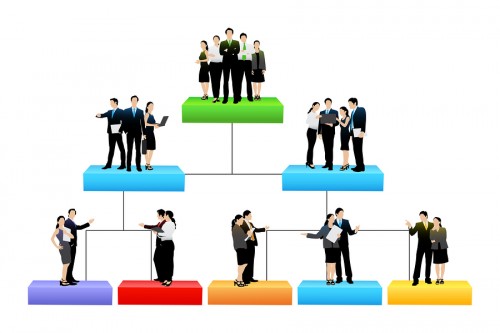I’ve been reviewing the history of organizations for a good reason. For a long time now, as a consultant to businesses, I’ve wondered if we aren’t using a faulty organizational model to get work done. Could we reinvent work and the way we manage people?
As people are called on to use more of their heads instead of their hands, maybe we need a new system in order to work together successfully. If we want to understand how organizations got to where they are today —for example, how come we use a hierarchical pyramid to organize work?— we need to review the history of organizations and ancient organizational models.
As Frederic Laloux explains in Reinventing Organizations: A Guide to Creating Organizations Inspired by the Next Stage of Human Consciousness, humankind has gone through stages of consciousness as we’ve increasingly handled more complex challenges.
- Reactive-Infrared Paradigm: This paradigm addresses humanity’s earliest developmental stage, spanning 100,000 to 50,000 BC. Humans lived in small bands of family kinships. These bands typically numbered just a few dozen people who foraged to survive. There was no division of labor, so there was nothing resembling an organizational model. There was no hierarchy, chief or leadership. There were usually high rates of violence and murder.
- Magic-Magenta Paradigm: Around 15,000 years ago, humanity started to shift into tribes of up to a few hundred people, representing a major improvement in members’ ability to handle complexity. Tribes sought comfort in ritualistic behaviors, following an elder or shaman with strong beliefs in spirits and magic.
Early Organization of Labor
- Impulsive-Red Paradigm: Around 10,000 years ago, chiefdoms and proto-empires evolved as the first forms of organizational life. Thinking was shaped by a black-and-white worldview: strong vs. weak, us vs. them.Role differentiation and divisions of labor existed, with a chief, foot soldiers and sometimes slaves. Some present-day organizations still operate with this model: prisons, crime cartels, countries at war or civil-war states. Gangs and inner-city neighborhoods may organize using the Red Paradigm.
A Red Organization’s defining characteristic is the chief’s use of overwhelming power to remain in position. There’s no formal hierarchy and no job titles, so this organizational model doesn’t scale well. Fear and submission keep the structure intact.
- Conformist-Amber Paradigm: Every paradigm shift opens up new capabilities and emerging ways for groups to get things done. Around 4000 BC, more sophisticated societies emerged in Mesopotamia. Humankind leaped from a tribal world subsisting on horticulture to the age of agriculture, states and civilizations, institutions, bureaucracies and organized religions.
A new class of rulers, administrators, warriors and craftsmen emerged. To feel safe in the world, members of the Amber Paradigm sought order, stability and predictability, creating control through institutions and bureaucracies. Societal roles and rules are well defined. They grasp cause-and-effect relationships and linear time, and they can project into the future. These capabilities foster self-discipline and foresight in planning.
Amber Organizations: With the Amber level of consciousness, organizations evolved because of two breakthrough ideas:
- Medium- and long-term planning
- Stable and scalable structures
These breakthroughs led to unprecedented innovation: irrigation systems, pyramids, the Great Wall of China, trading posts, merchant shipping and the Catholic Church.
The first large corporations of the Industrial Revolution were run on this paradigm. Amber Organizations are still very present today: government agencies, public schools, religious institutions and the military.
What do you think about these models? Do they contribute to your understanding of how we got to where we are today? As always, I’d love to hear from you. You can contact me here or on LinkedIn.

Did You Enjoy This Article?
Join thousands of other smart business owners like yourself & get our Proffittable Times newsletter.
It's filled with actionable content you can apply immediately.
Sign up now to get started!
– Coach Nancy










